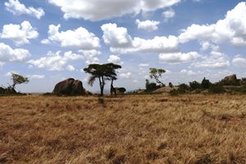Savannahs help to slow climate change

Carbon dioxide (CO2) exists naturally in the atmosphere, but it is also the greenhouse gas that is most altered by human activities, most notably fossil fuel combustion and tropical deforestation. The Earth’s vegetation reduces the increase in atmospheric CO2 concentrations by sequestering over a quarter of anthropogenic emissions. This so-called carbon sink results from the balance between plant photosynthesis, which annually takes up a significant fraction of the CO2 in the atmosphere, and a slightly smaller quantity of CO2 that is released back to the atmosphere through life processes (respiration) and wild fires. The vegetation’s resultant carbon sink slows down the rate of increase of greenhouse gases in the atmosphere and helps mitigate global climate change, thus providing a vital ecosystem service.
In an international study released in Science this week, researchers from the Max Planck Institute for Biogeochemistry in Jena, Germany, coauthored an international study led by researchers from Lund University in Sweden. They show that semi-arid ecosystems—savannahs and shrublands—play an extremely important role in controlling carbon sinks and the climate-mitigating ecosystem service they represent.
„Forest ecosystems including tropical and other major forest biomes take up most of the CO2 “, says Sönke Zaehle, group leader at the Max Planck Institute for Biogeochemistry. Tropical rainforests are highly productive, taking up a lot of carbon dioxide, but rainforests are crowded places with little room to fit in more plants to do more photosynthesis and to store carbon. In addition, the typical moist, hot weather conditions are ideal for growth and do not change much from year to year.
In savannahs it is different. As productivity increases there is room to fit in more plants whose growing biomass provides a sink, or store, for carbon sequestered from the atmosphere. In addition, savannahs spring to life in wetter years, thus causing large interannual fluctuations in carbon dioxide uptake between wet and dry years. Large enough, the scientists show, to dominate the variability of the carbon dioxide increase in the atmosphere. “Despite contributing only 20% to the vegetation’s carbon sink, savannahs are the largest controlling factor for year-to-year variations of the terrestrial carbon budget” says Markus Reichstein. We have long known that we need to protect the rainforests but, with this study, the researchers show that a heightened effort is needed to manage and protect the semi-arid regions of the world as well. They will become even more important in the future as climate variability and extremes increase in a warmer world.
“This study brings out clearly the importance of directing attention towards savannahs and other dry-climate ecosystems that have been largely neglected so far in climate policy discussions, and that moreover characterize the landscapes of some of the poorer countries of the Earth", says Benjamin Smith, Professor of Ecosystem Science at Lund University, Sweden.
Original publication
The dominant role of semi-arid ecosystems in the trend and variability of the land CO2 sink
Anders Ahlström, Michael R. Raupach, Guy Schurgers, Benjamin Smith, Almut Arneth, Martin Jung, Markus Reichstein, Josep G. Canadell, Pierre Friedlingstein, Atul K. Jain, Etsushi Kato, Benjamin Poulter, Stephen Sitch, Benjamin D. Stocker, Nicolas Viovy, Ying Ping Wang, Andy Wiltshire, Sönke Zaehle, Ning Zeng.
Science. DOI: 10.1126/science.aaa1668
Contact:
Dr. Sönke Zaehle
Abteilung Biogeochemische Integration
Max-Planck-Institut für Biogeochemie
07745 Jena
Tel: 03641-57 6230
Email: szaehle@bgc-jena.mpg.de
Prof. Markus Reichstein
Abteilung Biogeochemische Integration
Max-Planck-Institut für Biogeochemie
07745 Jena
Tel.: 03641-57 6200
Email: markus.reichstein@bgc-jena.mpg.de
Pressemitteilung (pdf)
